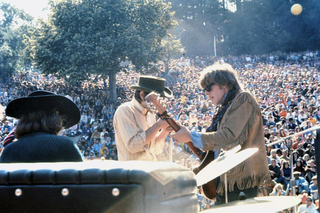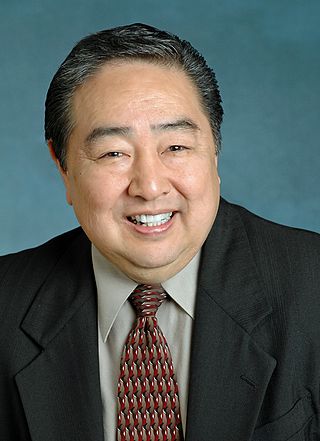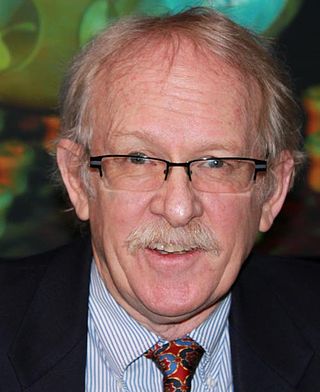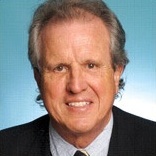
The Summer of Love was a social phenomenon that occurred during the summer of 1967, when as many as 100,000 people, mostly young people sporting hippie fashions of dress and behavior, converged in San Francisco's neighborhood of Haight-Ashbury. More broadly, the Summer of Love encompassed the hippie music, hallucinogenic drugs, anti-war, and free-love scene throughout the West Coast of the United States, and as far away as New York City.

Psychedelia usually refers to a style or aesthetic that is resembled in the psychedelic subculture of the 1960s and the psychedelic experience produced by certain psychoactive substances. This includes psychedelic art, psychedelic music and style of dress during that era. This was primarily generated by people who used psychedelic drugs such as LSD, mescaline and psilocybin and also non-users who were participants and aficionados of this subculture. Psychedelic art and music typically recreate or reflect the experience of altered consciousness. Psychedelic art uses highly distorted, surreal visuals, bright colors and full spectrums and animation to evoke, convey, or enhance the psychedelic experience. Psychedelic music uses distorted electric guitar, Indian music elements such as the sitar, tabla, electronic effects, sound effects and reverb, and elaborate studio effects, such as playing tapes backwards or panning the music from one side to another.
The Diggers were a radical community-action group of activists and street theatre actors operating from 1966 to 1968, based in the Haight-Ashbury neighborhood of San Francisco. Their politics have been categorized as "left-wing." More accurately, they were "community anarchists" who blended a desire for freedom with a consciousness of the community in which they lived. The Diggers' central tenet was to be "authentic," seeking to create a society free from the dictates of money and capitalism.

Haight-Ashbury is a district of San Francisco, California, named for the intersection of Haight and Ashbury streets. It is also called The Haight and The Upper Haight. The neighborhood is known as one of the main centers of the counterculture of the 1960s.
Drug rehabilitation is the process of medical or psychotherapeutic treatment for dependency on psychoactive substances such as alcohol, prescription drugs, and street drugs such as cannabis, cocaine, heroin or amphetamines. The general intent is to enable the patient to confront substance dependence, if present, and stop substance misuse to avoid the psychological, legal, financial, social, and physical consequences that can be caused.

Tod Hiro Mikuriya was an American medical doctor and psychiatrist. Known as an outspoken advocate for the use of cannabis for medical purposes and its legalization, he is often regarded as the grandfather of the medical cannabis movement in the United States.
Chester Leo "Chet" Helms, often called the father of San Francisco's 1967 "Summer of Love," was a music promoter and a counterculture figure in San Francisco during its hippie period in the mid- to-late 1960s.
Substance dependence, also known as drug dependence, is a biopsychological situation whereby an individual's functionality is dependent on the necessitated re-consumption of a psychoactive substance because of an adaptive state that has developed within the individual from psychoactive substance consumption that results in the experience of withdrawal and that necessitates the re-consumption of the drug. A drug addiction, a distinct concept from substance dependence, is defined as compulsive, out-of-control drug use, despite negative consequences. An addictive drug is a drug which is both rewarding and reinforcing. ΔFosB, a gene transcription factor, is now known to be a critical component and common factor in the development of virtually all forms of behavioral and drug addictions, but not dependence.

The Fillmore West was a historic rock and roll music venue in San Francisco, California, US which became famous under the direction of concert promoter Bill Graham from 1968 to 1971. Named after The Fillmore at the intersection of Fillmore Street and Geary Boulevard, it stood at the southwest corner of Market Street and South Van Ness Avenue in the Civic Center district. In June 2018, the top two floors of the building reopened as SVN West, a new concert and corporate event venue.

A drug is any chemical substance that causes a change in an organism's physiology or psychology when consumed. Drugs are typically distinguished from food and substances that provide nutritional support. Consumption of drugs can be via inhalation, injection, smoking, ingestion, absorption via a patch on the skin, suppository, or dissolution under the tongue.

The Haight Ashbury Free Clinics, Inc. is a free health care service provider serving more than 34,000 people in Northern California.
John Harvey Frykman Ph.D., was a Lutheran minister and American psychotherapist specializing in brief therapy, medical hypnosis and family therapy. He was the founding director of the drug treatment program of the Haight Ashbury Free Clinic in San Francisco, California, and is noted for his problem solving, individualized approach to substance abuse therapy and solution focused brief therapy.
During the "hippie" period 1967–1968 in San Francisco, an individual named Al Rinker started an organization located at 1830 Fell St in the city's Haight Ashbury district called the Switchboard. Its purpose was to act as a social switchboard for people living there.

The Mantra-Rock Dance was a counterculture music event held on January 29, 1967, at the Avalon Ballroom in San Francisco. It was organized by followers of the International Society for Krishna Consciousness (ISKCON) as an opportunity for its founder, A. C. Bhaktivedanta Swami Prabhupada, to address a wider public. It was also a promotional and fundraising effort for their first center on the West Coast of the United States.

Darryl S. Inaba, PharmD., was born June 16, 1946 in Denver, Colorado. He is the remaining owner and President of CNS Productions, Inc. in Medford, OR. He is an associate professor of Pharmacology at the UCSF Medical Center in San Francisco, California and the Director of Clinical and Behavioral Health Services at ARC in Medford, Oregon. He is also special consultant and instructor for the University of Utah School of Alcoholism and Other Drug Dependencies, as well as the Director of Education and Research at CNS Productions. Dr. Inaba is also on the editorial board of the Journal of Psychoactive Drugs, which has been published since 1967.

William Edgar Cohen was the president of CNS Productions, Inc. and co-author of Uppers, Downers, All Arounders, a textbook on the neurochemistry and neuropharmacology of psychoactive drugs. Additionally, he wrote and directed over two hundred teaching films and documentaries. Cohen was born in Washington, D.C. and raised in New York City.
CNS Productions is a publisher of educational materials — primarily textbooks and instructional DVDs — dealing with psychoactive drugs and addiction. It was formed in 1983 by Paul Steinbroner, with long-time collaborator William E. Cohen who had an extensive background in medical film production. CNS Productions has produced and distributed over fifty separate titles on issues related to the neurobehavioral effects of psychoactive drugs.

Paul J. Steinbroner was born March 18, 1949, in Los Angeles. In 1983, he founded CNS Productions, a publishing and distribution company specializing in topics related to addiction, neuropharmacology, and brain chemistry. He is the publisher of Uppers, Downers, All Arounders, a textbook on the neurochemistry and neuropharmacology of psychoactive drugs. Having previously produced informational and scientific documentaries, Steinbroner formed TouchPoint Productions to create a series of documentaries on transformational healing. Collectively known as Called From Darkness, the five part series examines willingness and spiritual awakening from five different cultural perspectives.
James Sanford Ketchum was a psychiatrist and U.S. Army Medical Corps officer who worked for almost a decade (1960–1969) on the U.S. military’s top secret psychochemical warfare program at the Edgewood Arsenal, Maryland, which researched chemicals to be used to "incapacitate the minds" of adversaries.
Stimulant use disorder is a type of substance use disorder where the use of stimulants caused clinically significant impairment or distress. It is defined in the DSM-5 as "the continued use of amphetamine-type substances, cocaine, or other stimulants leading to clinically significant impairment or distress, from mild to severe". These psychoactive drugs, known as stimulants, are among the most widely used drugs in the world today, although not all stimulants can induce addiction. Approximately 200 million Americans have used some type of stimulant in the past year alone.











